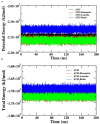Effect of Date Palm (Phoenix dactylifera) Phytochemicals on Aβ1-40 Amyloid Formation: An in-silico Analysis
- PMID: 35958986
- PMCID: PMC9359633
- DOI: 10.3389/fnins.2022.915122
Effect of Date Palm (Phoenix dactylifera) Phytochemicals on Aβ1-40 Amyloid Formation: An in-silico Analysis
Abstract
Alzheimer's disease (AD) is a neurodegenerative disease and the most prevalent form of dementia. The generation of oxygen free radicals and oxidative damage is believed to be involved in the pathogenesis of AD. It has been suggested that date palm, a plant rich in phenolic compounds and flavonoids, can provide an alternative treatment to fight memory loss and cognitive dysfunction due to its potent antioxidant activity. Thus, we studied the effect of flavonoids present in date palm on Aβ1-40 amyloid formation using molecular docking and molecular dynamics simulation. AutoDock. Myricetin was used as a positive control drug. The flavonoids Diosmetin, Luteolin, and Rutin were found to be potent inhibitors of aggregation (docking energies ≤ -8.05 kcal mol-1) targeting Aβ1-40 fibrils (both 2LMO and 6TI5), simultaneously. Further screening by physicochemical properties and drug-likeness analysis suggested that all flavonoids except Rutin followed Lipinski's rule of five. Rutin was, thus, taken as a negative control (due to its violation of Lipinski's rule) to compare its dynamics with Diosmetin. Diosmetin exhibited the highest positive scores for drug likeness. Since Luteolin exhibited moderate drug-likeness and better absorption properties, it was also included in molecular dynamics simulation. Molecular dynamics of shortlisted compounds (Rutin, Diosmetin, and Luteolin) were performed for 200 ns, and the results were analyzed by monitoring root mean square deviations (RMSD), root mean square fluctuation (RMSF) analysis, the radius of gyration (Rg), and solvent accessible surface area (SASA). The results proved the formation of a stable protein-compound complex. Based on binding energies and non-bonded interactions, Rutin and Luteolin emerged as better lead molecules than Diosmetin. However, high MW (610.5), lowest absorption rate (16.04%), and more than one violation of Lipinski's rule make Rutin a less likely candidate as an anti-amyloidogenic agent. Moreover, among non-violators of Lipinski's rule, Diosmetin exhibited a greater absorption rate than Luteolin as well as the highest positive scores for drug-likeness. Thus, we can conclude that Diosmetin and Luteolin may serve as a scaffold for the design of better inhibitors with higher affinities toward the target proteins. However, these results warrant in-vitro and in-vivo validation before practical use.
Keywords: Alzheimer's disease; Phoenix dactylifera (date palm); drug likeness and bioactivity; molecular docking (MD); phytochemicals (alkaloids/lignans).
Copyright © 2022 Zia, Rehman, Hashmi, Siddiqui, Bin Dukhyil, Ahmed, Jamal, Banawas, Almalki, Owais, Aldhafeeri, Ibrahim, Alturaiki, AlAjmi, Alsieni and Alqurashi.
Conflict of interest statement
The authors declare that the research was conducted in the absence of any commercial or financial relationships that could be construed as a potential conflict of interest.
Figures







References
-
- Ahmad S., Arsalan A., Hashmi A., Khan M. A., Siddiqui W. A., Younus H. (2021). A comparative study based on activity, conformation and computational analysis on the inhibition of human salivary aldehyde dehydrogenase by phthalate plasticizers: implications in assessing the safety of packaged food items. Toxicol 462, 152947. 10.1016/j.tox.2021.152947 - DOI - PubMed
-
- Ahmed M. Z., Zia Q., Haque A., Alqahtani A. S., Almarfadi O. M., et al. . (2021). Aminoglycosides as potential inhibitors of SARS-CoV-2 main protease: an in silico drug repurposing study on FDA-approved antiviral and anti-infection agents. J. Infect. Public Health. 14, 611–619. 10.1016/j.jiph.2021.01.016 - DOI - PMC - PubMed
-
- Al Qarawi A. A., Abdel-Rahman H., Mousa H. M., Ali B. H., El-Mougy S. A. (2008). Nephroprotective action of Phoenix dactylifera in gentamicin-induced nephrotoxicity. Pharm. Biol. 46, 227–230. 10.1080/13880200701739322 - DOI
-
- Al-Farsi M., Alasalvar C., Morris A., Baron M., Shahidi F. (2005). Comparison of antioxidant activity, anthocyanins, carotenoids, and phenolics of three native fresh and sun-dried date (Phoenix dactylifera L.) varieties grown in Oman. J. Agri. Food Chem. 53, 7592-7599. 10.1021/jf050579q - DOI - PubMed
-
- Aljaloud S., Colleran H. L., Ibrahim S. A. (2020). Nutritional value of date fruits and potential use in nutritional bars for athletes. Food Nutri. Sci. 11, 463–480. 10.4236/fns.2020.116034 - DOI
LinkOut - more resources
Full Text Sources
Miscellaneous

